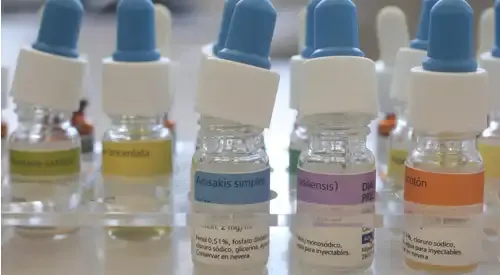Allergies
"At the moment we have a new way of immunotherapy, especially useful for children, which consists of applying drops under the tongue. This avoids punctures and can be applied at home".
DR. MARTA FERRER
SPECIALIST. ALLERGY AND IMMUNOLOGY DEPARTMENT

What is allergy?
The allergic reaction consists of the perception of our organism as harmful of a substance that is not (allergen). This contact triggers an exaggerated immune response that manifests itself in various organs of the body.
The most frequent allergens are: pollens, mites, animal epithelia, latex (or natural rubber, which is present in rubber gloves, probes, catheters, balloons, in pacifiers, bottle teats, etc.), wasp stings, certain foods and some medicines.
The allergen can come into contact with the body in several ways: inhaled through the nose or mouth, ingested (food or certain drugs), injected (drugs or insect stings) or through skin contact, causing contact dermatitis.
Immunotherapy has been shown to prevent allergy from worsening from simple rhinitis to developing asthma. Vaccines have evolved greatly in recent years: administration guidelines are faster and the allergenic extracts used are better standardized. They are especially effective in children.

What are the symptoms of allergies?
In order of frequency and severity, they can first produce a rhinitis or rhinoconjunctivitis that manifests itself by itchy nose and eyes, watery nasal discharge, sneezing, stuffy nose, etc.
Secondly, bronchial asthma. It should not be forgotten that 80% of all asthmatics are asthmatic due to allergic causes.
Asthma can initially manifest itself with a dry cough, fundamentally triggered by exercise, laughter or tobacco smoke. Later on, there is difficulty in breathing, thoracic noises (whistles or whistles), and a feeling of tightness in the chest. It can also manifest itself only when making efforts, for example climbing stairs, forcing us to stop because we are short of breath.
The most common symptoms are:
- Nasal congestion
- Rhinorrhea (increased nasal mucus)
- Sneezing
- Tearing and redness of the eyes
- Dry Cough
- Chest sounds when breathing
- Breathing difficulty
Do you have any of these symptoms?
You may have an allergy to some substance
How are allergies diagnosed?

The diagnosis of allergies is made by means of a skin test with the aim of reproducing on the skin the reaction that we present in other parts of the body.
It consists of applying drops to the skin of the arm containing the allergen to which we may be sensitive. With a minimum lancet the skin is crossed and the drops with the allergen are introduced. The reaction is observed after 15-20 minutes.
In addition, it is possible to perform blood tests, so that in a more precise way we can quantify and demonstrate the presence of specific antibodies.
In the case of foods or medicines, sometimes a provocation test is performed, observing under medical control the reaction after ingestion.
To diagnose bronchial asthma, respiratory function tests are performed.
How are allergies treated?
Our Immunotherapy Unit is formed by doctors and nurses with great experience in this treatment
The first and most effective measure is to avoid contact with the allergen. For this there are concrete recommendations.
Secondly, there are medications that are very effective in treating symptoms, such as antihistamines -now also available in eye drops and nose drops-; topical corticosteroids -inhaled through the mouth or nose which, unlike corticosteroids taken by mouth, are barely reabsorbed by the body and therefore lack systemic effects-; and other drugs.
It is important to know that all these treatments improve and control symptoms but do not cure allergy.
Today there is only one treatment that can induce tolerance to the allergen: immunotherapy (vaccines).
Immunotherapy consists of repeated injections of minimal doses of the allergen over a period of 3 to 5 years.
After that time, the vaccine achieves in a high percentage of people that our organism stops recognizing that substance as harmful and, therefore, the allergic reaction does not occur.
They are especially effective for the treatment of people allergic to wasp stings. They are also beneficial against pollens, mites and animal epithelia.
Because of the risk of producing allergic-type reactions, which is less than 5%, they are administered in Immunotherapy Units, formed by medical and nursing personnel who have sufficient experience to handle these treatments.
Para el tratamiento de pacientes alérgicos a alimentos se utilizan distintas estrategias:
- Desensibilizaciones: consiste en introducir, de forma lenta, progresiva y controlada por los especialistas, el alimento al que el paciente es alérgico (leche, huevo, un fruto seco, pescado, etc.). Es un proceso largo, y que implica riesgo de sufrir reacciones.
- Inmunoterapia oral: es el equivalente a las vacunas para la alergia respiratoria, pero administrada por vía oral. Está en fase de investigación y en nuestro Hospital estamos desarrollando un ensayo clínico con una vacuna para la alergia al cacahuete.
Where do we treat it?
IN NAVARRE AND MADRID
Department of Allergology
of the Clínica Universidad de Navarra
The Department of Allergy and Immunology of the Clinic is part of the Global Allergy and Asthma European Network, composed of the 25 best departments of Allergy in Europe, chosen for their scientific excellence, multidisciplinary work, teaching and international activities.
We have the most advanced diagnostic techniques, we are at the forefront of research and we collaborate with the best experts. We have more than 50 years of experience in the field.
What diseases do we treat?

Why at the Clinica?
- More than 50 years of experience.
- Pioneers in the technique of molecular diagnosis by microarray.
- Nursing specialized in allergic diseases and their care.








